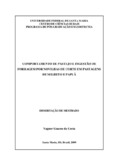| dc.creator | Costa, Vagner Guasso da | |
| dc.date.accessioned | 2009-04-03 | |
| dc.date.available | 2009-04-03 | |
| dc.date.issued | 2009-02-16 | |
| dc.identifier.citation | COSTA, Vagner Guasso da. Ingestive behavior and forage intake by beef heifers of tropical pasture. 2009. 69 f. Dissertação (Mestrado em Zootecnia) - Universidade Federal de Santa Maria, Santa Maria, 2009. | por |
| dc.identifier.uri | http://repositorio.ufsm.br/handle/1/10730 | |
| dc.description.abstract | The animal performance, ingestive behavior and forage intake by beef heifers in Pearl millet (Pennisetum americanum (L.) Leeke) and Alexandergrass (Urochloa plantaginea) were studied. The experiment was carried out between January and April of 2008, in the Department of Animal Science of the Federal University of Santa Maria. The grazing method utilized was continuous with variable number of animals. Four animal testers, beef heifers Aberdeen Angus crossbreed, with average weight of 260 kg and 15 months old were used in each paddock. The put and take technique was used to keep the forage mass around three t/ha of dry matter. The experimental design was completely randomized with repeated measures in time, three replications for Pearl millet and five for Alexandergrass. The animal performance, patterns of ingestion (bite mass, bite rate), animal behavior (grazing, idle and rumination), chemical and morphologic composition of the forage and animal forage intake were evaluated as output variables. The forage intake was measured in the vegetative and reproductive phenological stages of the plants utilizing the technique of chromic oxide. The animals were dosified during twelve days and the feces were collected during six days in each period of evaluation. The animal behavior was studied by visual observation in four 24-hour continuous periods. The ingestive behavior and the intake rate were similar between species. The variables measured in the pasture had not presented correlation with the components of animal behavior. The daily average temperature was negatively correlated with grazing time. The herbage intake, of 2.49% of the body weight, the weight gain of 0.779 g/heifer/day and the stocking rate of 6.7 were similar in Pearl millet and Alexandergrass (P> 0.05). The total digestible nutrient content, the canopy height, the bite mass and the relative humidity presented high correlation with the herbage intake and can be used in the development of models to predict the performance of grazing animals. The utilization of Alexandergrass infested areas, with grazing animals, provides similar animal performance as in Pearl millet pasture. | eng |
| dc.description.sponsorship | Coordenação de Aperfeiçoamento de Pessoal de Nível Superior | |
| dc.format | application/pdf | por |
| dc.language | por | por |
| dc.publisher | Universidade Federal de Santa Maria | por |
| dc.rights | Acesso Aberto | por |
| dc.subject | Óxido de cromo | por |
| dc.subject | Pennisetum americanum | por |
| dc.subject | Massa de bocado | por |
| dc.subject | Urochloa plantaginea | por |
| dc.subject | Taxa de bocados | por |
| dc.subject | Tempo de pastejo | por |
| dc.subject | Chromic oxide | eng |
| dc.subject | Pennisetum americanum | eng |
| dc.subject | Bite mass | eng |
| dc.subject | Urochloa plantaginea | eng |
| dc.subject | Taxa de bocado | eng |
| dc.subject | Tempo de pastejo | eng |
| dc.title | Comportamento de pastejo e ingestão de forragem por novilhas de corte em pastagens de milheto e papuã | por |
| dc.title.alternative | Ingestive behavior and forage intake by beef heifers of tropical pasture | eng |
| dc.type | Dissertação | por |
| dc.description.resumo | Foram estudados o desempenho, comportamento e ingestão de forragem por novilhas de corte em milheto (Pennisetum americanum (L.) Leeke) e papuã (Urochloa plantagínea),de janeiro a abril de 2008. Foi utilizado o método de pastejo continuo com número variável de animais. O delineamento experimental foi o inteiramente casualizado com medidas repetidas no tempo. Foram avaliadas as seguintes variáveis-resposta: desempenho, padrões de ingestão (massa de bocado, taxa de bocados e número de bocados), comportamento (tempos de pastejo, ruminação, ócio), composição química e morfológica da forragem e ingestão de forragem. As avaliações de comportamento foram feitas por meio de observação visual, em quatro períodos contínuos de 24 horas. Os valores médios de massa de forragem, oferta de forragem e oferta de lâminas foliares foram de 3927 kg/ha de MS, 14,6 kg de MS/100 kg de PC e 3,36 kg de MS/100 kg de PC, respectivamente. As variáveis do pasto, desempenho animal, comportamento ingestivo e ingestão de forragem foram semelhantes em milheto e papuã (P>0,05). A ingestão de forragem foi de 2,49% do peso corporal. As variáveis da forragem, desempenho animal e tempos de pastejo, ócio e ruminação e número de bocados por dia, apresentaram variação ao longo dos dias de utilização da pastagem (P<0,05). A média de ganho médio diário foi 0,799 kg/dia, e foi limitado pela ingestão de energia. A pastagem de papuã permite obter ganhos individuais e taxas de lotações semelhantes à pastagem de milheto. Em áreas infestadas com capim papuã, sua utilização em pastejo proporciona desempenho semelhante ao do milheto. | por |
| dc.contributor.advisor1 | Rocha, Marta Gomes da | |
| dc.contributor.advisor1Lattes | http://lattes.cnpq.br/1685524901627774 | por |
| dc.contributor.referee1 | Quadros, Fernando Luiz Ferreira de | |
| dc.contributor.referee1Lattes | http://lattes.cnpq.br/9202266292366562 | por |
| dc.contributor.referee2 | Genro, Teresa Cristina Moraes | |
| dc.contributor.referee2Lattes | http://lattes.cnpq.br/7693817385839216 | por |
| dc.creator.Lattes | http://lattes.cnpq.br/3245650400402571 | por |
| dc.publisher.country | BR | por |
| dc.publisher.department | Zootecnia | por |
| dc.publisher.initials | UFSM | por |
| dc.publisher.program | Programa de Pós-Graduação em Zootecnia | por |
| dc.subject.cnpq | CNPQ::CIENCIAS AGRARIAS::ZOOTECNIA | por |


